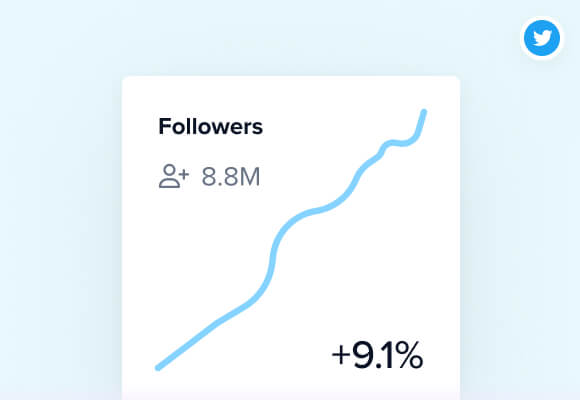Free Twitter Follower-to-Following Ratio Calculator

HypeAuditor’s Twitter Follower-to-Following Ratio Calculator provides the ability for influencers, brands, and agencies to quickly assess the popularity of any Twitter account. The follow ratio calculator can also be used to speed up initial discovery of Twitter influencers or rival content creators.
When assessing an influencer’s popularity, it’s useful to be able to swiftly calculate their Twitter follow ratio. An influencer’s follow ratio helps businesses filter out influencers who don’t merit further consideration, and it can be used by influencers as a way to find potential rivals or weigh the idea of a joint collaboration.
Twitter Follower-to-Following Ratio Calculator Questions
What Is the Twitter Followers to Following Ratio For an Influencer?
A follower following ratio on Twitter is a measure of how many followers a user’s account has in relation to how many people they follow. The Twitter following to followers rate can be used as an indicator of an influencer’s popularity on the social media platform. An account with a high follower-to-following ratio on Twitter has a larger audience than the number of accounts it follows. This may indicate that the influencer has successfully increased their follower count or is selective about who they follow. A user with a high ratio is generally considered to be more influential.
How to Calculate the Ratio of Followers vs Following on Twitter?
Twitter users' following vs follower ratio is simply calculated by counting the followers and dividing it by the number of accounts being followed. As an example, if a creator has 10,000 followers and follows 5,000 they will have a 2:1 ratio of followers to following on Twitter.
What Is a Good Twitter Followers to Following Ratio?
Since there is no definitive benchmark, the concept of a good follower to following ratio on Twitter is subjective. Balanced followers vs following, however, can vary based on a number of factors. Users with new accounts are in the process of building their followers count on Twitter. In the beginning, they might follow many other people whose tweets interest them or are simply trying to expand their network. Because of this, it is likely that their Twitter follower to following ratio is 1:1 or slightly lower, but that doesn’t necessarily mean it is of low quality.
However, having a high value doesn’t automatically indicate the person tweets regularly or shares something that many people would find interesting. Celebrities, media personalities, or other well-known individuals outside of social networks quickly grow their followers on Twitter and can afford to follow relatively few accounts because of their status and popularity, making their Twitter following vs followers ratios exceptionally high.
For this reason, businesses must use their own criteria to determine what a reasonable Twitter follower following ratio is for them. Good followers vs following ratio on Twitter may depend on the quality and consistency of the creator’s content, their engagement, their knowledge of relevant topics, and whether their Twitter account is promoted on other social media platforms.
As a rule of thumb, a user should follow a maximum of as many Twitter accounts as many followers they have. That is, if they have 5,000 followers on Twitter their following should be the same, resulting in a 1:1 ratio.
Is It Better if Influencers Have More Twitter Followers than Followings?
In general, it is better if a creator has more followers than the number of accounts they follow. A higher number of followers than following suggests that an influencer has an established social media presence and credibility. Fewer followers, however, mean that the user follows more accounts than other users follow them.
Poor Twitter followers vs following ratios can be attributed to a variety of elements.
- The user posts infrequently, or their tweets are not interesting enough to attract a huge audience.
- The person is on Twitter primarily to consume content, thus they follow significantly more accounts than they have followers.
- Some individuals try to grow their audience by engaging in shady activities like the follow-for-follow strategy. This involves users following a lot of Twitter accounts in hopes of gaining a follow back. However, if not all accounts follow them back their follower to following ratio on Twitter will be unbalanced.
- The account was created recently and for now, the account owner has a higher number of followings than followers.
When Evaluating Creators, Does the Twitter Follower Ratio Matter?
It does carry weight since it gives brands and agencies some insights when analyzing Twitter influencers for potential partnerships. The metric measures a user’s influence and reach on Twitter. Popular social media creators have a significantly higher follower base than their following. High Twitter following to followers ratios may suggest that their tweets are captivating and attract a lot of attention, or they are well-established figures and have built a good rapport with their audiences. Businesses and marketers often seek out influencers with large audiences in the hopes of generating more engagement, boosting conversions, and expanding their reach. However, the Twitter followers vs following rate should be used as an entry point to sort out low-quality accounts in a mass recruitment process, or combined with other metrics during an in-depth influencer screening.
Is the Following to Followers Ratio Alone Enough to Analyze Twitter Influencers?
The Twitter follower-to-following ratio provides an initial impression of a Twitter account’s status and recognition, but relying solely on it can be misleading and might not reflect a Twitter influencer’s true value. As this is the primary metric brands and agencies encounter, many of them base their influencer selection exclusively on it. Consequently, numerous users began using auto-follow methods to grow their followers or buy fake accounts, which negatively affected brands’ reputations or caused financial damage.
To pick the right Twitter creator for a collaboration, businesses, and marketing professionals must analyze a range of performance metrics, like content quality, posting consistency, engagement, brand fit, credibility, and target audience suitability. The ratio of followers to following on Twitter should be viewed as a piece of a larger puzzle.













